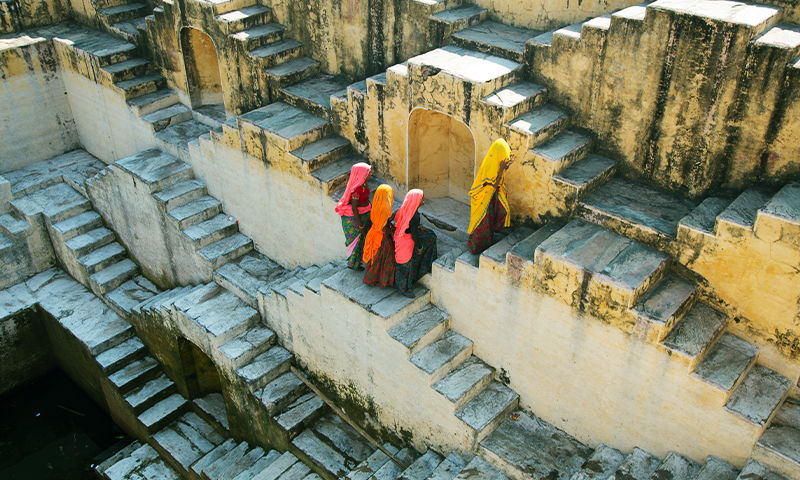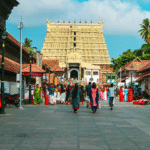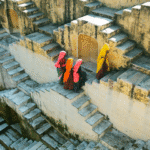
Step into a cool, shadowed world and you will find some of India’s most surprising masterpieces not overhead in domes and spires but underfoot. Carved into the earth, folding the sky into step geometries and secret stairways, Stepwell. They are an ancient system of water harvesting, social hubs, temples and canvases for sculpture or ornaments. India’s stepwells are the perfect element that highlights the rich culture, architecture and history of the country. The majority of stepwells are located in the hot, arid regions of Northern India in states like Gujarat, Rajasthan, and Haryana. These Stepwells are the places where engineering met devotion, where climate-smart design created art. Although the knowledge about these stepwells is limited but they narrate the beauty of the rulers and invaders’ era with their marvellous sculptures and artwork. This post walks you through the stories of Stepwells, why they matter today and gives you a guided tour of the most stunning Hidden stepwells in India still waiting to be discovered:
At first glance a stepwell looks like a sunken courtyard with steps descending into cool still water. But their genius runs deeper. In arid and seasonally dry regions of India, stepwells serve as a reliable groundwater access point. They are designed to reach water even as the water table drops in arid regions. Their step formed allowed people to reach the water at varying levels. Their subterranean galleries cut the temperature dramatically offering respite from heat and their niches and chambers supported rituals and social gatherings. They blend Hindu and Islamic decorative vocabularies, royal patronage and public utility, enlivening precision and lyrical ornamentation.
Think of a stepwell as an inverted temple. Going down steps is like descending into a sacred microclimate towards the source of life, water. This intersection of function and artistry is why many of these structures survive as treasured architectural wonders today. Many of them are UNESCO World Heritage Stepwell India and are recognized for their exceptional architectural and cultural significance.
Here is the list of some of the hidden stepwells that you must visit to witness India’s rich culture, history and architecture with a new perspective:
If there is a single Stepwell that most people associate with the phrase, “architectural wonder,” it is Rani Ki Vav in Patan, Gujarat. This unique stepwell was built in the memory of Bhimdev Solanki by his widowed Queen Udaymati in the Chalukya Dynasty during 1063 to 1068 AD. Located on the bank of the River Saraswati, it was rediscovered after being silted for centuries and carefully restored. This 900 years old structure is widely celebrated for its ornamental and because UNESCO inscribed it as a World Heritage Site in 2014.
Architecturally, Rani Ki Vav is designed as an inverted temple; the deeper you descend the closer you come to the well sanctum and sculpture pantheon that adorn its walls. It has ‘Dashavatars’ or the ten incarnations of the deity theme. With 500 main sculptures and 1,000 lesser ones on its panels blends divine iconography with secular scenes carved in stone. It is suggested to plan your Rani Ki Vav trip during early mornings or late afternoon when the lights slant along the reliefs and the step traces through long cinematic shadows. This Stepwell rewards slow looking, each niche tells a different story.
Timings: 8:00 AM – 6:00 PM
Entry Fee: INR 35 (Indians), INR 550 (Foreigners)
How to Visit Rani Ki Vav Stepwell Gujarat:
Nearest Airport: Sardar Vallabhbhai Patel International Airport in Ahmedabad (123 km)
Nearest Railway Station: Ahmedabad Junction (127 km)
One of the most visually arresting stepwells in India is Chand Baroi in Abhaneri, Rajasthan. This famous stepwell near Jaipur was built by King Chand during the 8th and 9th centuries to help locals access clean groundwater easily. It is famous for its vast, geometric honeycomb of steps that plunge into the earth in an almost mathematical symmetry. Visitors frequently stop, stare and then imagine the multitudes of feet that must have trodden those 3500 steps over a thousand years. With steps on its three sides, it is more than 13 storeys deep into the ground. It’s a dramatic inversion of architectural weight that makes the well read like an open air amphitheater sunk into the desert. The Baori is also set next to the Harshat Mata, the goddess of joy and Happiness. This anchors the site’s devotional contact and leaves travellers in awe. Its design is stark in its repetition, where Rani Ki Vav is a narrative gallery, and Chand Baori is an exercise in pattern and proportion. Maintained by the Archeological Survey of India, this beautiful stepwell showcases the Rajasthani architectural expertise and talents. The interplay of light and dark, step and niche, produces an almost hypnotic rhythm. Because of its grid like architecture and uniqueness, it is one of the Stepwells featured in movies in India like Bhool Bhulaiyya, The Fall, The Dark Knight Rises, and for photography.
Entry Fee: INR 20 (Indians), INR 250 (Foreigners)
How To Visit Chand Baori:
Nearest Airport: Jaipur International Airport (95 km)
Nearest Railway Station: Bandikui Junction (33 km)
Adalaj Stepwell is located 3 to 4 km to the south-west of Gandhinagar, Gujarat. Also known as Adalaj Ki Vav, it is a quieter but no less haunting beauty. Carved from local stones and richly ornamented with floral patterns, human figures and geometric motifs, it is smaller in scale but rich in narrative details. It was built by Queen Rudabai in memory of her husband in 1499. This five-storey stepwell is a synthesis of Hindu and Islamic architectural elements, reflecting the layered history of the region. The Well of Tugunal Pavallian and Lateral Chambers form a cool and echoing space that once provided social shelter for travellers and transfolk.
Its intricate carvings make it a visual feast and a testament to how stepwalls live in popular memory as a sight of personal and communal drama and utility. It showcases the fine craftsmanship of stone carvers who transformed a pragmatic structure into an art full of enclosure. As sunlight filters through the octagonal opening of the Stepwell, this light and shadow adds to its allure.
Timings: 9:00 AM – 5:00 PM
Entry Fee: No entry fee
How To Visit Adalaj Stepwell:
Nearest Airport: Sardar Vallabhbhai Patel International Airport (15 km)
Nearest Railway Station: Sabarmati Railway Station (11 km)
In the bustle of New Delhi, Agrasen ki Baoli sits like a cool and stone pause between busy streets and glass fronted offices. This long, narrow stepwell is set close to Connaught Place and Jantar Mantar, making it a popular spot for locals and visitors alike. Though the exact origin of Agrasen ki Baoli is debated, some place its foundation to the legendary King Agrasen of the Mahabharata era. This ancient water reservoir occupies 60 meters long and 15 meters wide space.
While architectural clues suggest medieval rebuilding during the Tughlaq period. Its presence in the urban fabric of Delhi is a reminder of how ancient water solutions were once woven into civic life. Today it is a protected monument under the Archaeological Survey of India. It rises from the depths of the earth to stand atop 103 stone steps that are built over three levels. The Baoli has clean lines and a clostric verticality with repeated arches framing the water below. Over the years, it’s collected stories from cinematic appearances and whispered tales of haunting.
Timings: 7:00 AM – 6:00 PM
Entry Fee: No entry fee
How To Visit Agrasen ki Baoli:
Nearest Airport: Indira Gandhi International Airport (15 km)
Nearest Railway Station: New Delhi Railway Station (3 km)
Rjatasgan is studded with stepwells and Toorji ka Jhalra in Jodhpur is a prime example of one being woven into modern city life. It was built by Rani Toorji, the wife of Maharaja Abhay Singh in the early 18th century with red rose sandstone. Restored in recent years by the JDH Urban Regeneration Project, Toorji ka Jhalra has become an architectural relic and civic stage for small markets, cultural exhibits and community life. This shows how heritage conservation reconnects historic structures to contemporary use. Its intricate carvings of Gods, Goddesses sculptures, dancing elephants, medieval lions and cow waterspouts, curved arches and layered steps reflect local materials and aesthetics.
This 250 years old structure is made to provide groundwater access to locals throughout the year. This well is over 200 feet which originally had a Persian Wheel that was driven with the help of bullocks. Its top level has a patoo in the traditional Chhatri style while the other two levels have protruding Jharokhas and a corridor to get the perfect view of the well. This place has been recognized as the most iconic tourist attraction and one of the best destinations for photography in India.
Timings: Throughout the day
Entry Fee: No entry fee
How To Visit Toorji ka Jhalra:
Nearest Airport: Jodhpur Airport (4.5 km)
Nearest Railway Station: Jodhpur Junction (2 km)
If you plan to explore stepwells, here are some practical tips to keep your visit mindful and rewarding:
Recognition brings tourists and tourists can fund conservation but also threaten it. We, Memorable Indi, promote a balance between opening sites to the public and preserving their fragile details. Rani Ki Vav UNESCO statues brought attention and funds enabling high quality conservation while smaller sites often rely on local NGOs, tour operators like us or the municipality. Proper conservation requires trained archaeologists, community support and maintenance plans that address both structure and setting. Urbanization poses a further challenge, encroaching on construction, pollution and changes in groundwater recharge patterns. This alters the very hydrology that makes stepwells viable. Conservation then, must be interdisciplinary combining architectural conservation with urban planning, hydrology and community engagement to keep these gems for our future generations. We, as a travel agency, and you as a reader and traveller, should keep the dignity of these historical sites intact by conserving them for our generations to come. We are donating a few percent of our packages to the conservation programs to maintain the richness of these stepwells.
Stepwells are architectural features that ask us to bend down and look. They require a different kind of attention, a willingness to step out of the ordinary, trace carved lines with fingers and eyes, listen to water’s muted presence and whispers of history. In a world grappling with water scarcity and climate stresses, stepwells remind us how design can be elegant and ecological at once. They are also symbolic, public investments in shared resources, communal gathering places and canvases for craftsmanship. Protecting stepwells is about conserving ways of thinking, an integrated approach to nature, technology, art and society that produces structures both functional and beautiful. Next time you plan to explore India, look down as well as up. The countries’ architectural treasures are not all on the rooftop many of the most remarkable narratives are carved into the earth, waiting a step below. Book your India Heritage Tour To Stepwells today. We are waiting to hear from you.

Best Things to Do in Kerala for a Memorable Holiday
26 Sep 2025
Architectural Wonders Underfoot: India’s Most Stunning Stepwell
23 Sep 2025
From Taj Mahal to Tropical Shores: Why Golden Triangle with Goa is a Must-Do
16 Sep 2025
Sunsets & Serenity: Top Beach Spots to Unwind in India
12 Sep 2025
Top Cultural Experiences to Try in Varanasi for Foreign Tourists
04 Sep 2025